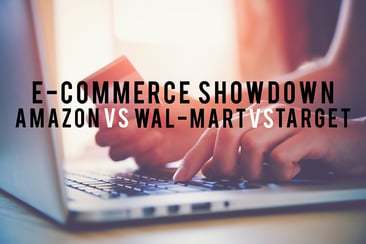 As we as consumers all know, e-commerce is a huge and vital part of the retail industry in 2015. How do the outlooks on e-commerce differ or align between some of the top retail giants in the nation?
As we as consumers all know, e-commerce is a huge and vital part of the retail industry in 2015. How do the outlooks on e-commerce differ or align between some of the top retail giants in the nation?
In this blog, we take a look at the e-commerce for three top retail companies: Amazon, Wal-Mart and Target.
Wal-Mart's Heavy Bet on E-Commerce
As we mentioned in an earlier blog, Wal-Mart Stores Inc. says, "its heavy investment in e-commerce infrastructure is paying off, with online sales growing by double-digit percentages, but that it hit a rough patch in international online sales.” Wal-Mart will spend between $190 million and $295 million on e-commerce this year. To accommodate added logistical demand, Wal-Mart has built large-scale warehouses dedicated to fulfilling online orders. It now has five such facilities, each the size equivalent of 20 football fields, from which it will be able deliver to 95 percent of country in two days.
None of the big 3 retailers have much choice when it comes to this type of spending if they intend to remain competitive within the online retail market. This is only the beginning of a new normal in retail shopping. The convenience of the online shopping experience and multiple home delivery options is certainly here to stay.
Target’s Equally Aggressive E-Commerce Investment
Target said it would spend $1 billion in fiscal year 2015 on strengthening its digital capabilities and supply chain. Expecting an industry wide increase in e-commerce sales this year, Target plans to take a “channel-agnostic approach” to growing its business. This will drive the total Target experience throughout online, mobile and stores.
As the move to online shopping grows, in-store shopping will fall. Target will likely have to reduce their in-store jobs in an effort to transform its business over the coming years. Job elimination seems to be an intended casualty of these recent technology applications in the retail market. It all started with self-checkout lanes. Some major retailers are testing robotic customer service assistants in technology friendly markets. For example, Lowe’s is testing robots to roam its isles to answer basic customer service questions such as item location. The robots are also capable of performing a Google search for you on "how to...whatever you’re working on". You then enter in or speak your email address and the search results are sent to you via email.
Amazon Won't Be Outdone In E-Commerce
Amazon is arguably the industry expert in online ordering and fulfillment. It’s the 56th largest company in America by market capitalization. It’s the 15th biggest retailer in America by revenue and by far the largest Internet retailer.
Amazon is able to collect endlessly useful information about shoppers and use it to sell more stuff by targeting customers through e-mail and the website itself. Amazon may have the most intelligent e-commerce programming to date. Whenever a customer buys something from Amazon or views products without buying something, Amazon is collecting all kinds of information about that person.
There’s a lot of data that can be mined about how people peruse the website, what they put in their cart, what they abandon and how the customer actually goes about searching for a product. A tracking code, known as a "cookie" is embedded in the shoppers’ web browser after viewing specific items. When the shopper visits other sites, images of recently viewed products on Amazon can appear on those other sites like Facebook and Yahoo. With this retargeting, Amazon has a way of subtly reminding you that you had viewed this particular item but did not buy.
What's Ahead
This year’s holiday season will be an online brawl between these three retailers for online customers. If we look at unique monthly website visitors, Amazon has a considerable lead at 175 million. Wal-Mart is a distant second at 82 million, and Target has 51 million. Clearly Amazon is the more popular online choice, but aggressive pricing guarantees and delivery options this holiday season could close the gap.
The trick to this business, as any other is, of course, to generate a profit. Wal-Mart leads the way in 2014 with $16.3 billion in net income. Target was second with $1.9 billion and Amazon lost $241 million.
Wal-Mart and Target did not separate online sales from gross revenue on their income statement, so these numbers are difficult to compare. Amazon had a $210 million interest expense charge in 2014, which resulted largely in their negative net income.
It's difficult to guess who will come out on top for 2015 online sales, but one thing is for sure. Online sales and home delivery will only increase every year to come.



 Land-Link, a well respected professional organization, has been providing its clients with effective transportation and logistics solutions since 1978.
Land-Link, a well respected professional organization, has been providing its clients with effective transportation and logistics solutions since 1978.

